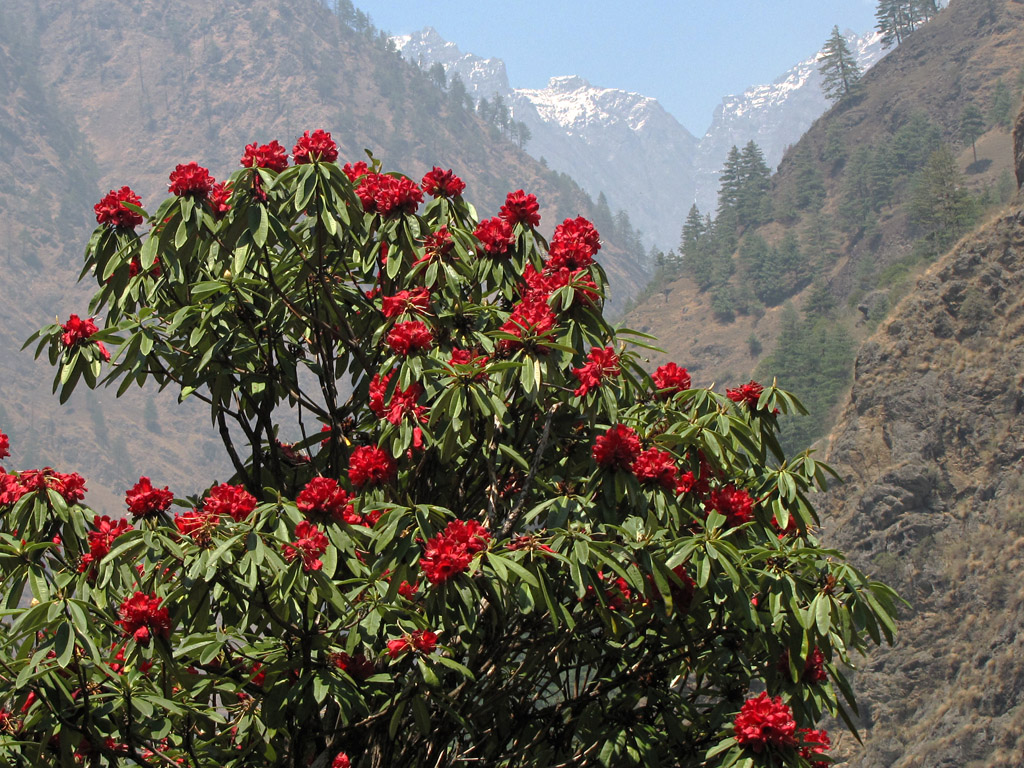
From Wikimedia, Spencer Weart, CC BY-SA 3.0
Tibet
Rhododendron arboreum
Rhododendron arboreum

From Wikimedia, Spencer Weart, CC BY-SA 3.0
General Description / Cultural Significance
Tibet, an autonomous region in the southwest of the People’s Republic of China, is renowned for its rich biodiversity and cultural heritage. Among its diverse flora, rhododendrons hold a particularly significant place. With well over a thousand species—many of them fragrant and endemic—rhododendrons have long been integral to the daily lives and traditions of Tibetans.
The blossoms of Rhododendron arboreum, known for their fragrance, are used to make jams, jellies, and a regional fermented beverage. A distinctive rhododendron-based wine called Guranse, brewed in the Darjeeling Hills, is reputed to help prevent altitude sickness. Additionally, locals prepare a medicinal tea from the plant’s dried twigs to treat fevers.
In Tibetan indigenous medicine, known as Pso-ring-pa, rhododendrons play a vital role. Each part of the plant serves a purpose: the leaves are ground into a paste to treat high fevers and headaches, the bark is powdered and used as snuff for colds, and dried flowers fried in ghee are consumed to prevent dysentery. The wood, used for crafting utensils, can also be dried and powdered to make a fever-reducing tea.
Beyond its medicinal applications, the rhododendron is revered as a sacred plant. Its flowers are frequently used as offerings in religious rituals and temple ceremonies. The species display a stunning range of colors, from deep reds and vibrant pinks to pure whites and soft yellows. Their forms vary dramatically, from ground-hugging alpine varieties to towering tree-like species rivaling oaks in size. Tibet is considered a global center of rhododendron diversity, with some of its rarest species thriving at higher elevations.
Climate Change / Conservation Status
The impacts of climate change on Tibet and its biodiversity, including Rhododendron arboreum, are profound and far-reaching. Tibet’s rapidly warming climate threatens not only its fragile high-altitude ecosystems but also the cultural and ecological balance that has existed for centuries. The retreat of glaciers, shifts in precipitation patterns, and degradation of permafrost are altering the natural environment in ways that affect both plant and animal life. The disruption of Rhododendron arboreum’s flowering cycles, habitat loss, and increased susceptibility to wildfires and diseases highlight the urgent need for conservation efforts.
Beyond its ecological importance, Rhododendron arboreum holds deep cultural and medicinal significance for Tibetan communities. Its loss or decline would not only mean a disruption of local biodiversity but also the erosion of traditional knowledge and practices that have been passed down through generations. The decline of such species can have cascading effects on indigenous traditions, livelihoods, and even the spiritual identity of the region, as the rhododendron is an important plant in Buddhist rituals and local folklore.
To mitigate these threats, a multi-faceted conservation approach is necessary. Scientific research must be combined with traditional ecological knowledge to develop strategies that support both environmental sustainability and cultural heritage preservation. The establishment of protected areas and biodiversity corridors can facilitate species adaptation to changing climates, while afforestation and habitat restoration efforts can help maintain soil stability and ecological balance. Additionally, promoting climate-resilient rhododendron species and fostering sustainable harvesting practices will ensure that the plant continues to serve its traditional roles without further endangering its populations.
On a larger scale, tackling climate change in Tibet requires a global effort. Reducing carbon emissions, addressing industrial pollution, and promoting climate-conscious policies at national and international levels are critical in slowing the pace of environmental change. As Tibet plays a crucial role in Asia’s water security, the consequences of its environmental degradation extend far beyond its borders, affecting millions who rely on the region’s water sources.
The fate of Tibet’s rhododendrons, along with the broader ecosystem, ultimately depends on the balance between conservation efforts and climate action. If proactive measures are taken, there is hope for preserving these species and the rich cultural and ecological tapestry they represent. However, without immediate and sustained intervention, Tibet’s rhododendron forests—along with their ecological, medicinal, and spiritual significance—could become yet another casualty of climate change.
Alternate Names
Tree Rhododendron
Himalayan Rhododendron
Red Rhododendron
Sources
Srivastava. (2012). Rhododendron Arboreum: An Overview. Journal of Applied Pharmaceutical Science, 2(1), 158-162.
Bhattacharyya, D. (2011). Rhododendron Species and Their Uses with Special Reference to Himalayas – A Review. Assam University Journal of Science & Technology, 7(1).
Morell, V. (2002). China Hotspot. National Geographic. 201(4): 98-113.

